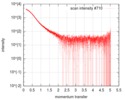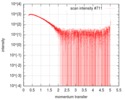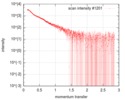+Search query
-Structure paper
| Title | Molecular Organization of Soluble Type III Secretion System Sorting Platform Complexes. |
|---|---|
| Journal, issue, pages | J Mol Biol, Vol. 431, Issue 19, Page 3787-3803, Year 2019 |
| Publish date | Sep 6, 2019 |
 Authors Authors | Ivonne Bernal / Jonathan Börnicke / Johannes Heidemann / Dmitri Svergun / Julia A Horstmann / Marc Erhardt / Anne Tuukkanen / Charlotte Uetrecht / Michael Kolbe /  |
| PubMed Abstract | Many medically relevant Gram-negative bacteria use the type III secretion system (T3SS) to translocate effector proteins into the host for their invasion and intracellular survival. A multi-protein ...Many medically relevant Gram-negative bacteria use the type III secretion system (T3SS) to translocate effector proteins into the host for their invasion and intracellular survival. A multi-protein complex located at the cytosolic interface of the T3SS is proposed to act as a sorting platform by selecting and targeting substrates for secretion through the system. However, the precise stoichiometry and 3D organization of the sorting platform components are unknown. Here we reconstitute soluble complexes of the Salmonella Typhimurium sorting platform proteins including the ATPase InvC, the regulator OrgB, the protein SpaO and a recently identified subunit SpaO, which we show to be essential for the solubility of SpaO. We establish domain-domain interactions, determine for the first time the stoichiometry of each subunit within the complexes by native mass spectrometry and gain insight into their organization using small-angle X-ray scattering. Importantly, we find that in solution the assembly of SpaO/SpaO/OrgB/InvC adopts an extended L-shaped conformation resembling the sorting platform pods seen in in situ cryo-electron tomography, proposing that this complex is the core building block that can be conceivably assembled into higher oligomers to form the T3SS sorting platform. The determined molecular arrangements of the soluble complexes of the sorting platform provide important insights into its architecture and assembly. |
 External links External links |  J Mol Biol / J Mol Biol /  PubMed:31288030 PubMed:31288030 |
| Methods | SAS (X-ray synchrotron) |
| Structure data |  SASDC68: Surface presentation of antigens protein, SpaOc (Surface presentation of antigens protein SpaO SpaO(SPOA2), SpaOc)  SASDC78: Surface presentation of antigens protein SpaOc-SpaO(SPOA1,2)  SASDC88: Surface presentation of antigens protein SpaO(SPOA1,2) N-terminus  SASDC98: Surface presentation of antigens protein SpaOc-SpaO N-terminus  SASDEJ7: The InvC-ATP synthase, surface presentation of antigens and oxygen-regulated invasion protein (ISO) complex  SASDEK7: SpaO C-terminus (Surface presentation of antigens protein SpaO(SPOA1,2) C-terminus) |
| Source |
|
 Movie
Movie Controller
Controller Structure viewers
Structure viewers About Yorodumi Papers
About Yorodumi Papers




 Salmonella enterica subsp. enterica serovar typhimurium (bacteria)
Salmonella enterica subsp. enterica serovar typhimurium (bacteria)